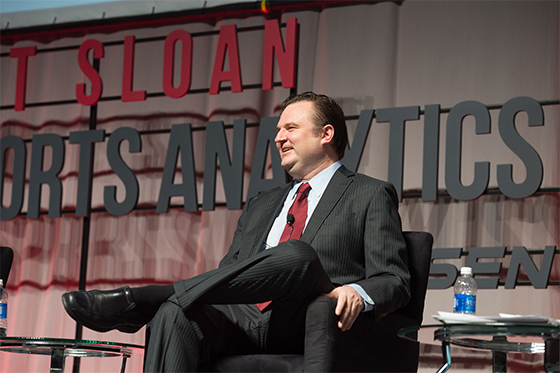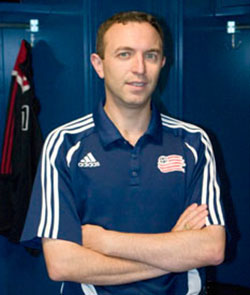Data Driven: The MIT-Infused Rise of Sports Analytics
-
-
slice.mit.edu
Filed Under
Recommended

In February 2007, Daryl Morey MBA ’00 convened a small, one-day conference of about 175 MIT students, sports fans, and professionals. The sessions were held in MIT classrooms and focused on a niche topic—sports analytics, or the use of advanced statistics to employ data-driven strategy in athletics.
Nearly seven years later, thanks in part to the success of that conference, that topic has exploded in relevance, and the annual MIT Sloan Sports Analytics Conference (SSAC) has positioned MIT as a pivotal part of the burgeoning sports analytics industry.
“We held the first conference at MIT basically because I was an alum and they were supportive,” says Morey, the SSAC conference co-chair who, in 2004, helped Sloan initiate one of the first MBA programs with a sports analytics courses. “Today, analytics, sports, and MIT makes perfect sense.”
The two-day conference annually attracts a sold-out audience of nearly 3,000 attendees that includes more than 300 owners, players, and representatives from the highest-level professional teams in the U.S. and Europe.
Morey is perhaps the most well-known MIT alum working in professional sports—he is general manager and managing director of basketball operations for the NBA’s Houston Rockets—but he is not alone. Nearly every team in the U.S.’s top professional leagues has created analytic-specific positions to help determine in-game and business strategy, and MIT alumni are a small but growing group that is filling those roles.

“More alumni are getting involved in sports because the analytical skillset is becoming more valuable and more appreciated,” says Brian Bilello ’97, president of soccer’s New England Revolution. “I studied chemical engineering but MIT didn’t necessarily train me to be a chemical engineer. They trained me to solve chemical engineering problems, and I can apply that perspective to my job with the Revolution.”
Sports teams now use analytics to provide a deeper level of analysis beyond traditional data. In baseball, front offices that once relied on well-known stats like home runs and runs batted in now place greater emphasis on advanced metrics like VORP (Value Over Replacement Player), a calculation created by Keith Woolner ’90 that demonstrates how much a player contributes to his team in comparison to a near-average replacement player at the same position.
After graduating from MIT, Woolner worked in software development and system management in Silicon Valley for more than a decade. As a hobby, he wrote stat-heavy articles for Baseball Prospectus (BP), an organization devoted to advanced statistics. In 2007, he parlayed his analysis to a position with the Cleveland Indians, where he works as director of baseball analytics and focuses on metrics for player valuation and game strategy.
“I always viewed my writing as being more of a scientist—I gathered information and presented it,” Woolner says. “In the early days at BP, we were very much the outsiders. By the time I joined Cleveland, I came into an organization that was data-driven and had buy-in towards analytics.”
The Venn diagram of MIT and sports may never have a ton of people in the middle. But the MIT skillset fits perfectly with what teams are trying to accomplish.
The outdated idea of a team’s front office is one of retired coaches who have graduated to executive positions. In reality, most teams employ a group with varied expertise that includes scouts, former players, and stat-focused analysts and executives.

“Front offices today are very balanced—traditional scouting backgrounds mixed with analytics backgrounds,” says Farhan Zaidi ’98, the Oakland Athletics’ director of baseball operations. “Much like MIT, sports now live in a very hypothesis-driven environment. You need to ask the right questions, accumulate the right data, and implement a strategy based on that data.”
While the number-crunching approach to improving on-field performance has gained significant attention—see Moneyball, the 2011 film starring Brad Pitt—teams are also taking an analytical approach unrelated to in-game strategy.
As vice president of business planning and basketball analytics for the NBA’s Phoenix Suns, Zaheer Benjamin MBA ’03 oversees an analytics team that focuses on diverse areas of Suns business, including marketing, ticket sales, and increasing revenue.
“Customer scoring models, for example, are something a lot of other industries do very well and sports is just getting up to speed on,” he says. “We use it to predict how likely season-ticket holders are to renew their ticket packages and align our resources to be as efficient as possible.”
While it continues to grow in popularity—Fast Company named the conference the third-most innovative sports organization in the world in 2012—it remains an MIT-rooted event. The conference’s organizing committee includes more than 60 MIT Sloan alumni and current students.
“That Venn diagram of MIT and sports may never have a ton of people in the middle,” Morey says. “But the MIT skillset fits perfectly with what teams are trying to accomplish. I’ve already hired one MIT alumni. I’d hire five more if I could.”
The 2014 conference takes place Feb. 28-March 1 in Boston and offers reduced-rate tickets for MIT alumni. Visit sloansportsconference.com for more information.







